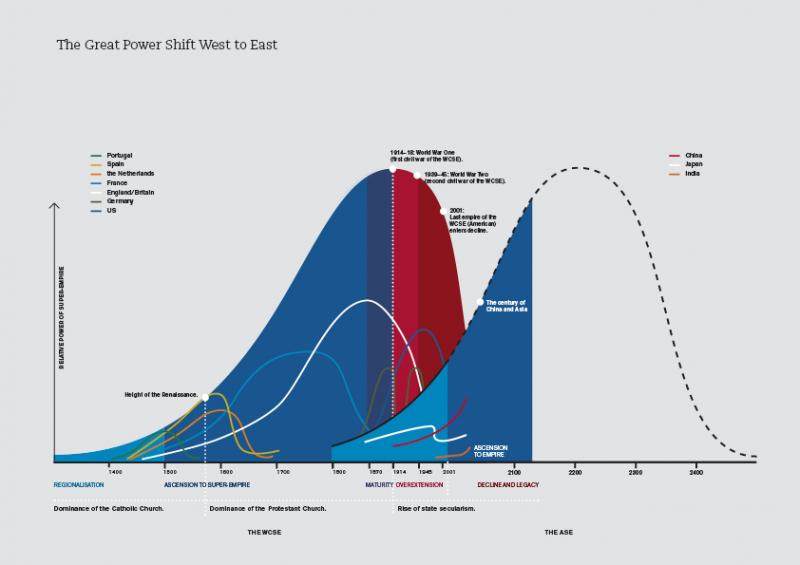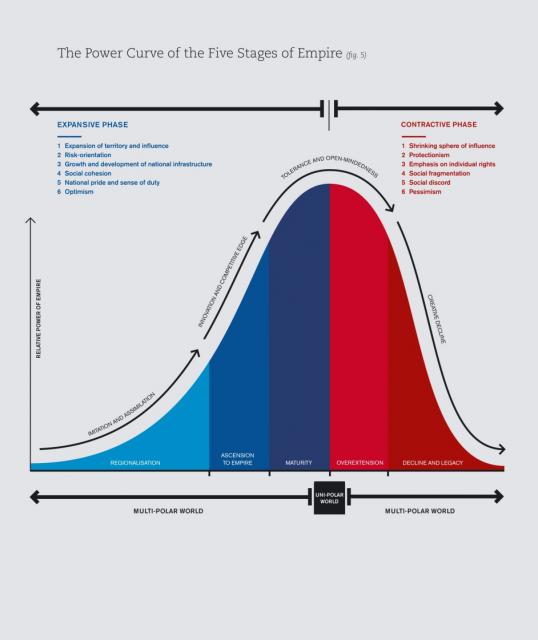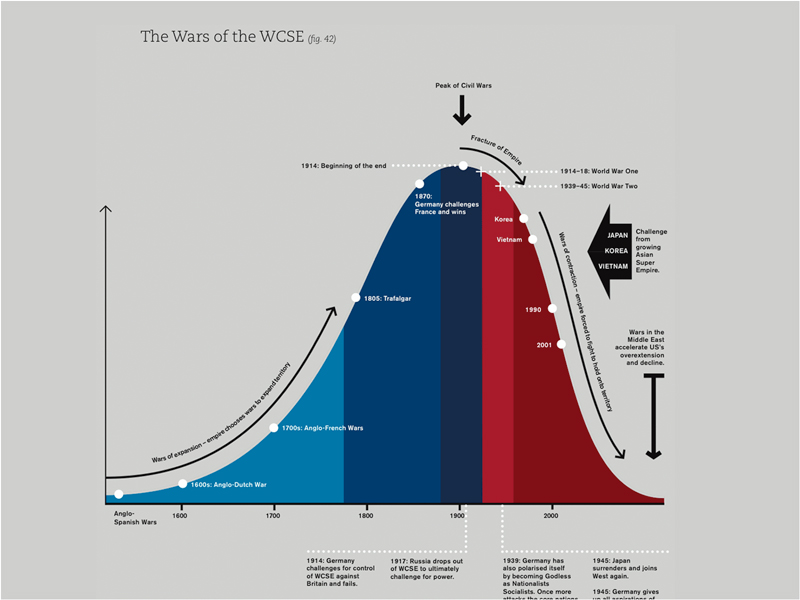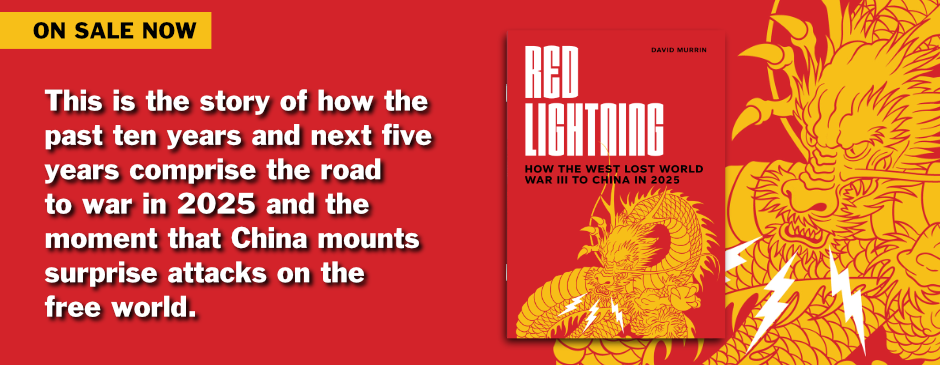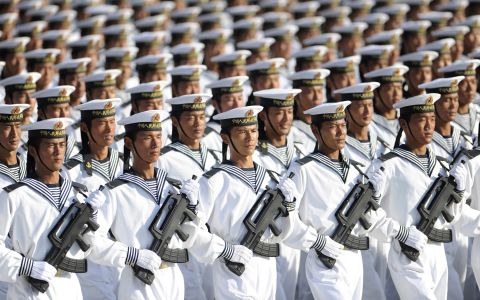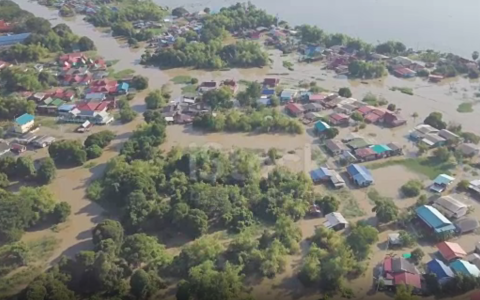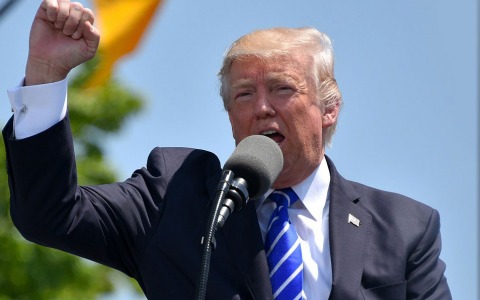The Five Phase Life Cycle of Empires (as discussed on my free podcast) - a model of the growth and decline of civilisations - can provide a way both to understand history’s ‘big picture’ and to accurately assess current and future geopolitical environments. To illustrate the influence and power projection possessed by an empire, Figure 5 uses a graphical representation of the five stages similar to a Gaussian curve - a statistical probability distribution of data around an average. Empires are not all the same, of course, but the majority of them exhibit a similar distribution, peaking at about 60-70 percent along their life cycles. The Five Stages of Empire, then, are as follows:
- regionalisation;
- ascension to empire;
- maturity;
- overextension;
- decline and legacy.
These five stages can be compared to the human life cycle, beginning with birth and a period of nurturing, and followed by independence, self-expression and the manifestation of one’s capabilities in the world. A peak is reached after, say, four or five decades; if it could be measured, it would comprise a mixture of wealth, energy, health, contentment, power and creativity. Finally, the decline towards death begins, completing the cycle.
As an empire grows, the world around it tends towards uni-polarity, until at its peak it comes to dominate its surroundings. Then, as it declines, there is a trend towards multi-polarity as it weakens and its neighbours strengthen.
Empires embody a critical dynamic balance between investment, defence, consumption and protectionism. The first two characteristics dominate the growth phases of an empire, as the rising power seeks to build its future and ensure its growth and survival. The third and fourth characteristics become dominant during the contractive phases, when the priority is protecting the status quo and maintaining a high standard of living, not investing in the future. (A comparison can be made with an elderly person who generally does not invest in their future but instead consumes during the last years of life.)
As I have discussed, demographics lie at the heart of an empire’s growth, and they provide a measure of its energy, predisposition to risk and value system. Moreover, all empires display a social composition divided between the core population and the workforce that has freed it to focus on expansion. As we have seen, in ancient times, slaves and serfs filled this role. Since the abolition of slavery in the West, they have been replaced by indentured labour, colonial subjects and the working classes. (Figure 6 relates the Five Stages of Empire to the demographics of the population.)
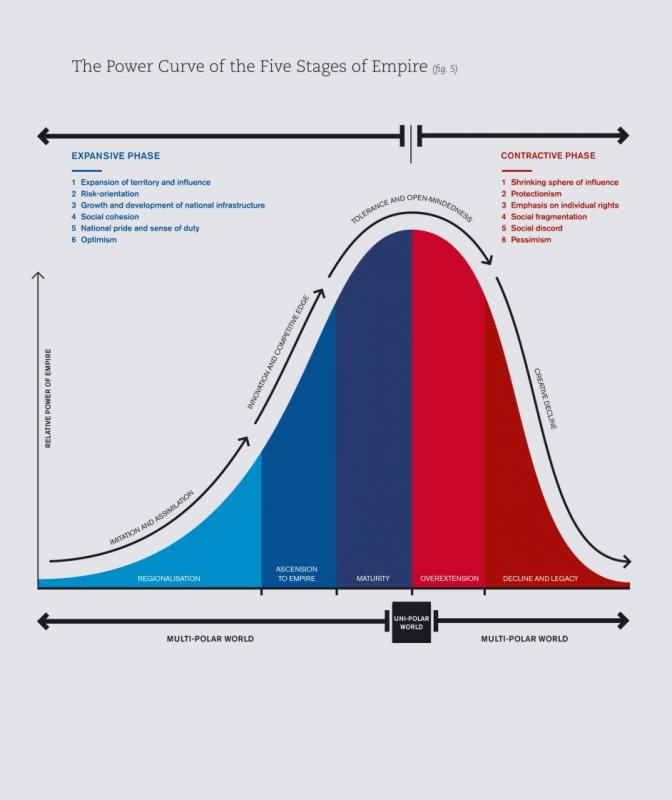
The Expansive and Contractive Phases
The first three stages of an empire - regionalisation, ascension and maturity - are associated with the qualities of expansion; optimism; appetite for both individual as well as collective risk; investment in national infrastructure; a sense of cohesion and national duty; social cooperation; pride in national achievements and values; and, as the limitations of material-world comfort are experienced, the search for individual happiness and spiritual fulfilment.
During the expansive phase, growth is not linear but occurs in spurts interspersed with pauses for consolidation. As the region or empire becomes more economically powerful, it seeks to extend its influence as far and wide as possible. There are no cases in history in which a wealthy country with strong demographics has not chosen to militarise its economic wealth, justifying such action by trade protectionism, territorial control, political influence and domination of the widest possible economic sphere.
With industrialisation, the size and power of empires have increased, along with the destructive potential of their war-making capacity. Nations must now carefully consider the cost/benefit analysis of making war. As a result, they may commit hostile acts that are economic rather than military by nature. The new global economy has helped by creating a common arena in which the players can compete in trade. However, it would be a grave mistake to be lulled into a similar false sense of security as were the nations of the world prior to World War One, who erroneously believed that the close linking of global trade mechanisms would prevent war. All global trade does is to raise the threshold for all-out war; it does not render it obsolete.
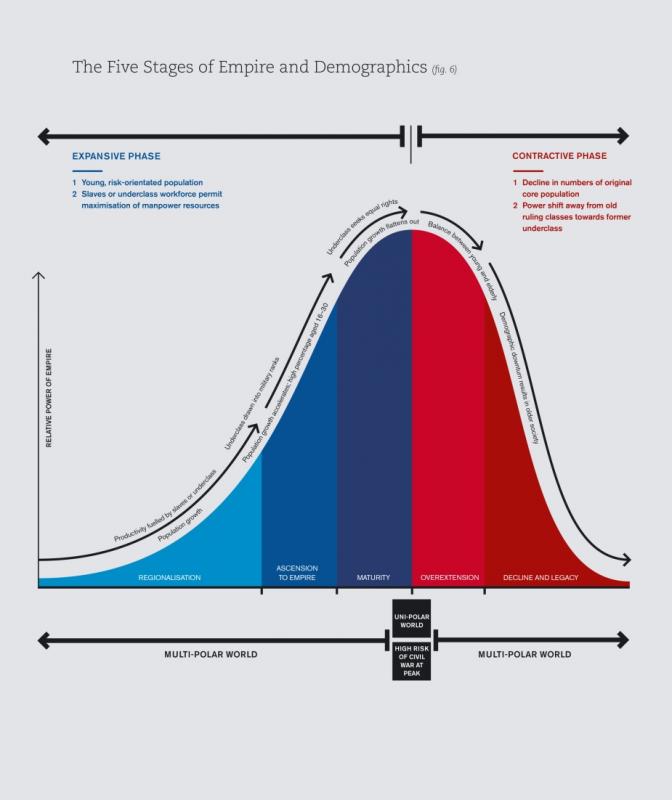
The last two stages of empire - overextension and decline - are governed by the process of decline. Its hallmarks include a lack of social cooperation (with a decline in resources every person begins to act in their own interest); an emphasis on the rights of the citizen as opposed to a sense of duty to the nation; protectionism; the inability of the empire to use foresight to invest in vital infrastructure for its future survival; unhappiness and a sense of exclusion; the fracturing of society into social sub-groups; social discord; and pessimism.
Regionalisation: The First Stage of Empire
Early in the growth of a regional power, a struggle occurs between various states within the same geographical vicinity, with the victor amalgamating all of the others. (Rome, for example, absorbed other city-states before going on to control the whole of the Italian Peninsula.) This enlarged state then becomes a player in the game of nascent empires, aiming to expand further until it attains imperial status. As discussed, the key driver prompting this behaviour is a growing population, which both needs to be fed and provides extra risk capital. The wealth of a new regional power increases through conquest, the development of new trade relationships and the spoils of war (with which the army and society are rewarded).
The regionalised entity’s political and military establishments then take root, along with the society’s core values. The military would, by this point, have developed a well-honed edge, making it a formidable opponent - although it would still be a long way from becoming the dominant force in its sphere of influence. Plans for expansion would continue to take into account the asymmetry of the regionalised power base in contrast with the local hegemon. The regional power would seek to make gradual and incremental gains until enough strength had been accumulated for a direct confrontation.
The catalyst propelling a nation from regional power to empire is the point at which it can no longer sustain its economy internally, particularly with respect to the acquisition of natural resources, so it is forced to look outside its borders. The crystallising moment comes when its military becomes strong enough to take on the powers around it with a good chance of success.
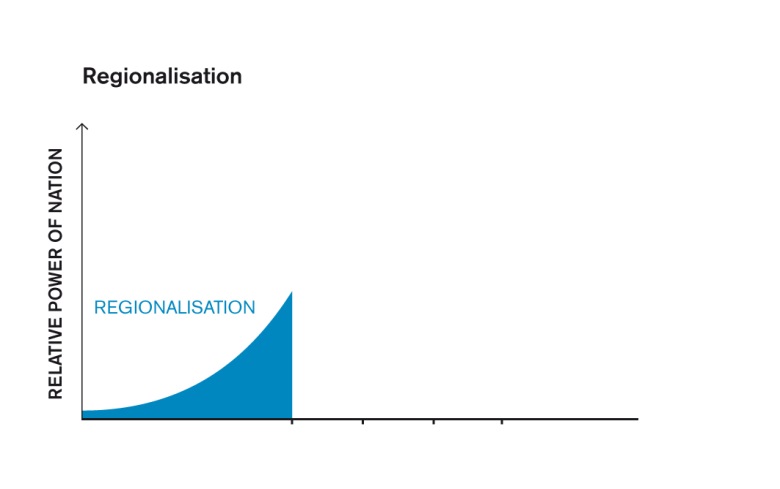
As an empire’s core population increases, so does its demand for an enlarged menial workforce to match its growing economy and to focus the core population’s energies on expansion. Traditionally, the army drove this demand: as the need for it to expand became more urgent, manpower was redirected from the maintenance of an agrarian economy. Additional labour was then required in the fields to grow and harvest crops. The Spartan solution was to annex other lands and rededicate the subjugated populations to food production, thereby freeing the Spartans to form one of the first large and permanent armies. (As discussed, slaves satisfied the need for a menial workforce for millennia.)

Civil war often attends rising empires that are approaching the end of their regionalisation stage. For the regional power in question - assuming it survives its civil war intact - the conflict can act as a coalescing agent, preparing the nation for the quantum leap to ascension to empire. Examples include the English Civil War (1641-51), the American Civil War (1861-65) and the Chinese Civil War (1927-37 and 1945-49).
Whilst the nations of Africa are in this phase of Empire, the most relevant example of this model is Britain today, the only Western nation in an expansive phase. The Brexit issues are thus seen as the first democratically contained Civil war with all the underlying forces at play.
https://www.davidmurrin.co.uk/blog-entry/brexit-part-2-on-the-way-to-a-…
In comparison the EU is in the phase of decline and Legacy, and such time is not in its favour when grappling with Brexit or any other structural issue. https://www.davidmurrin.co.uk/blog-entry/brexit-options
The Fractal of Regionalisation
Understanding the relationship between a regional power and an empire is essential to grasping one of the most critical drivers for change in geopolitics at any one time. At what stage do regional powers become empires? What happens to regional powers that bid for empire but fail?
The regionalisation stage is a fractal of the Five Stages of Empire. There are early and late stages of regionalisation, followed by maturity, overextension and decline. The inflection point - at which a nation either remains a regional power or ascends to empire - occurs at the maturity stage within the regionalisation cycle. If the demographic trend at this point exhibits momentum and continues to grow, it will force the regional power to expand as a result of an ever-pressing need for resources. The more forceful the demographic surge, the more likely the shift from regional power to empire. (Figure 7 is the by-now-familiar Five Stages of Empire graph, but this time showing the fractal of regionalisation and the inflection point.)
However, the success of a regional power in its challenge will directly relate to the status of others situated within or near its domain. If it has no competitors, the regional power will certainly become an empire. However, if other potential empires of the same order exist in the vicinity, the challenger will only have a reasonable chance of success if one of those powers has reached the overextension stage in its own cycle, thereby creating a power vacuum. Timing is, therefore, crucial as to whether or not a new empire comes of age.
Failure by the challenger could result in its absorption by the victor, but might also result in the challenger’s rapid overextension and decline. It will then subsequently reorganise itself to repeat the cycle. Thus, Rome’s triumph as a regional power was also about Carthage’s failure as a mature, overextended state. France built a limited continental empire in the eighteenth century, yet failed to successfully challenge British power in the race towards a global maritime empire. It was therefore limited to the status of regional power in a struggle that lasted for 100 years. France did make two further challenges during this time, as a revolutionary and then later an imperial power, but ultimately failed in both attempts. Similar examples include Germany’s challenge to the British Empire in 1914 and 1939, and Japan’s offensive against the Asian and Pacific territories of the Western powers in 1941-42. All resulted in the collapse of the regional challenger, which subsequently underwent a new regional cycle.
Whilst a successful Brexit unconstrained by the limitations of the EU would move Britain beyond a regional state into a more influential phase. Failure and containment by the EU and or a Labour Government would knock Britain back down the curve for up to a decade. However Britain would in the long run try again to surmount its current EU limitations driven by its significant national energy.
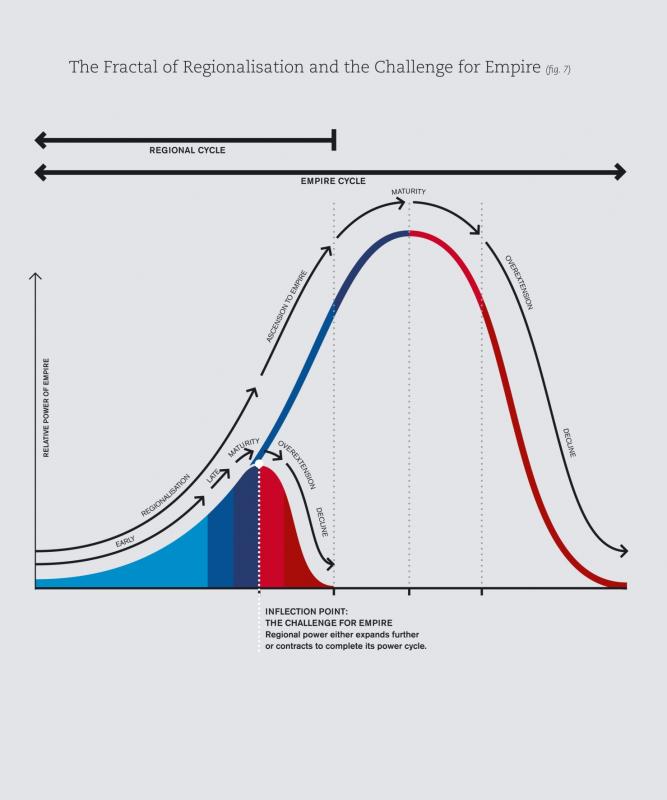
Ascension: The Second Stage of Empire
When a regional power successfully absorbs a number of similar rivals, it then spreads out, projecting its power further. This process marks the ascension stage. Once again, smaller entities are amalgamated and absorbed (e.g. Macedonia and Greece, Rome and Carthage). The algorithm of growth (given a simple model consisting of nothing but regional powers) operates as follows. When one entity conquers another, it becomes twice powerful as the next entity it takes on; all things being equal, it will therefore succeed half the time. By the time the ascending empire has assimilated three regional powers and attacks a fourth, it will require only a quarter of the time to succeed as it did for the original conquest. This stage of growth is the most heady and dynamic, as the wealth and power of the new empire increase exponentially. Income from expansion is vastly greater than expenditure.
Demographic expansion is once again the key, pushing regional powers to expand their influence and bring in raw materials to sustain their economies. The population will be achievement-and risk-orientated a big advantage in confrontations against rivals in a mature, overextended or declining phase of the empire cycle. The ascension phase is characterised by clear, strategic planning and execution, along with an extensive degree of confidence that is expressed as a sense of collective destiny.
Britain entered its ascension stage early in the mid-sixteenth century. It had ample supplies of wood, bronze and iron with which to build ships, but its economy was underdeveloped. It opted to acquire a share of Spain’s wealth through privateering and freebooting, and in the process obtained the financial resources (gold and silver0 to allow it to ascend to empire. American imperial evolution began with the early twentieth-century oil boom and the motor industry. China began its own ascension in 1996, rather quietly, without anyone paying much attention; it is now aggressively projecting its power into the outside world in a bid to corner resources.
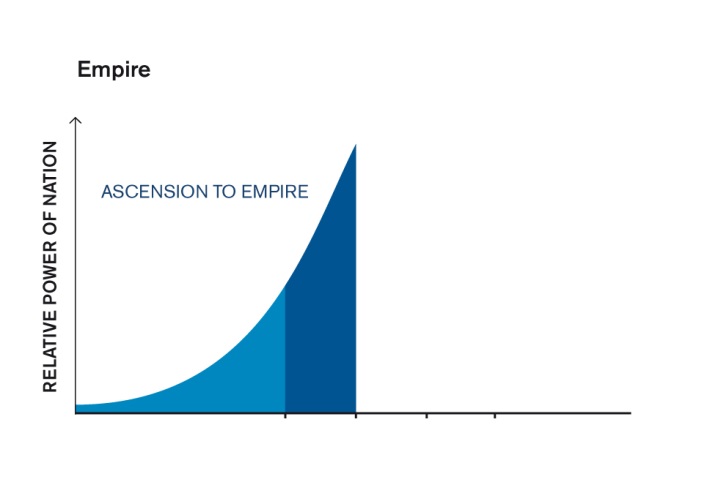
Recalling the law of competition in determining the longevity of an empire, and ascending power seeking to supplant an established, mature one can only do so when the hegemon begins to decline. During the ascension stage, the core population of the ascending civilisation swells with a high concentration of people thirty years old or younger. Imbued with the qualities of youth, it is therefore expansive, risk-orientated, resilient and flexible, ready to embark on wars of accretion.
This risk-positive factor is further pronounced in cultures where males predominate significantly over females. China’s population today, for example, is 56 percent male, and therefore has 5 percent extra risk capital to employ during its ascension stage.
Continued population growth also facilitates and supports the manpower drain caused by military expansion and war-making. Demand for a menial workforce is very high as the economy expands.
Today China is the only example of a nation operating in the stage. However the implications are truly monumental with respect to China’s attempt to challenge America for Global dominance within the next decade.
https://www.davidmurrin.co.uk/blog-entry/the-deadly-dance-of-the-eagle-and-the-dragon-part-4-the-dragon-ascending-to-empire-again
Maturity: The Third Stage of Empire
In the cycle of empire, a phase of equilibrium and stability naturally follows a period of conquest and expansion - assuming the borders of the new empire are well defined and well defended, and the administrative system highly organised: this is the maturity stage of empire. Without gains from conquest, a stable economy is required to generate enough revenue both to sustain a defensive army and to maintain civil harmony. Over time, income and expenditure become balanced during this stage. In its mature stage, Rome restricted the size of its army under Augustus to 300-400,000 men, in order to balance the budget. Even more extreme was the Western Jin Dynasty’s attempt to generate a huge peace dividend in China in the third century ad, after attaining supremacy over all of its challengers: the entire army was disbanded. However, neither the Roman nor the Chinese strategy was ultimately successful in forestalling the eventual decline of their respective empires.
The beginning of imperial maturity is often witness to sweeping social changes within the empire. Population growth slows, and the ratio of young to old becomes more balanced. The drive to expand decelerates, and the empire enters a period of unmatched prosperity. The core population grows wealthy, achieving a high standard of living, which blunts the tougher qualities that drove previous generations during the regionalisation and ascension stages. When new wars erupt, the empire finds itself beset by a manpower shortage for the first time that can only be solved by inducting the menial workforce into the military. Once such wars are over, the returning soldiers from this class reject their former lowly status and demand equal rights of citizenship. The core population begins to integrate with the awakening menial workforce, but the reins of power are still held by the former. Significant internal power shifts by the end of the (subsequent) overextension stage usually result from the social changes initiated during maturity.
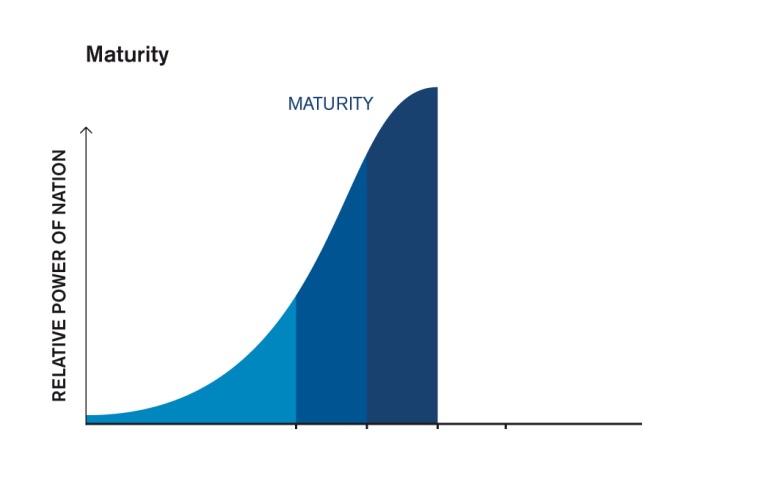
A frequent characteristic of empires near the end of the maturity stage is the advent of peak civil war. Without an external target to act as a focus for an empire’s aggression, its leaders turn inward, and a power struggle results. Such conflicts can weaken the empire significantly. The distraction may also provide a strategic opening for any up-and-coming regional power awaiting the right opportunity to strike. Such critical moments can be particularly explosive in the case of rigid power structures, such as dictatorships and monarchies. On the other hand, democratic empires may witness a more subtle internal struggle between competing groups. In Britain, the decade that followed the Boer War saw a great deal of political upheaval that, according to Winston Churchill, took the empire to the brink of civil war. The US in recent years has seen the radical politics of the Bush-era neo-Conservatives come into play, representing a dramatic swing away from traditional American values and producing a backlash with tumultuous political consequences.
If we accept that empire cycles are unavoidable, and therefore that mature empires will witness significant power struggles, then the value of democracy as a political system can be viewed in a new light. It may well be the solution to prolonging periods of peaceful development. Inherent in the democratic structure is a means of ‘blowing off steam’, allowing, if necessary, a change in direction without resulting in the sorts of revolutionary, traumatic changes that can leave an empire vulnerable to outside powers. In effect, democracies seem to be better equipped to cope with such stress; unpopular elements can be replaced in elections rather than through the extremes of civil war; the process protects the empire overall.
There are no nations today operating in this phase.
Overextension: The Fourth Stage of Empire
Overextension signifies the onset of gradual decline, beginning at levels apparent only to the most astute observers and ending in financial disasters and military challenges.
At some point an empire’s success induces complacency, arrogance, corruption and other manifestations of decay, as the comforts of civilised society give rise to expectations by the middle classes that the status quo will be maintained. The transformation of an empire from ‘barbarian’ to ‘civilised’ is now complete, and over time it will become ripe for domination by another aspirant. In the early stages of overextension, the cost to the economy of running an empire is no longer compensated for by revenue. The empire then begins to increase its debt burden, preventing a rise in military expenditure precisely at a time when it is most threatened by new challenges.
The Roman and British Empires each displayed such signs of overextension before declining. As I have posited, the most likely challenge to an established civilisation is always posed by a power that the decaying empire perceives as ‘barbarian’: one that is riding a growth curve with less to lose and more to gain from open conflict, able to act with greater aggression and fewer inhibitions to achieve its goals. For Rome, the Goths embodied this role; for Britain, it was the US. The ‘barbarian’ presumption, of course, conveniently masks the reality that the challenger is more developed than the declining power’s complacency allows it to discern. The current US perception of both the Islamic world and the People’s Republic of China exactly fits this model.
World War Two provides a compelling instance of the problems facing a civilised society fighting a ‘barbarian’ empire. By the time the Allied forces had left Normandy’s beaches and begun the battle for Germany, it had become clear to the Allied generals that they faced problems in motivating and leading a democratic army that placed a high value on individual life. There were critical delays in the prosecution of the land war against Germany as a result. The Russian Red Army, in sharp contrast, was truly barbaric in its advance on Berlin. From the turning point of the Battle of Stalingrad, Russia pushed on relentlessly, despite incurring massive casualties on both sides, right up to the fall of the German capital. Had the Russian army not torn the guts out of the Wehrmacht on the Eastern Front, it is doubtful that the US and Britain could have invaded Europe in 1944; global sea dominance and supreme air power could not by themselves have forced Germany to surrender its continental empire. Of course, the advent of the nuclear bomb would in any case have compelled Germany’s capitulation, as it did Japan’s. Yet there is a certain irony that, without one ruthless atheist totalitarian empire to counter the other, the outcome of the war might have been very different for the democratic powers.
It is certainly difficult to motivate an overextended empire to fight when its people have a high standard of living. Since 1945, the US has become increasingly reliant on its technology to ensure that American wartime casualty rates remain low. However, in wars such as those in Iraq and Afghanistan, where there is no alternative to soldiers on the ground, considerable public outcry over fatalities occurs.
Wars are expensive, more so as technology bleeds from the hegemon to the challengers, making it very costly to maintain the military edge. In the overextension stage, a dominant empire will not reduce social or defence commitments, nor increase taxation. It moves rather into financial deficit, which saps its strength. Financial-market peaks take place past the pinnacle of the empire cycle, as the system finds ways to increase spending by raising debt. During these periods, there is always talk of reducing costs, but doing so proves consistently unsuccessful. The demise of the USSR as an empire was hastened by military spending against a backdrop of declining revenue.
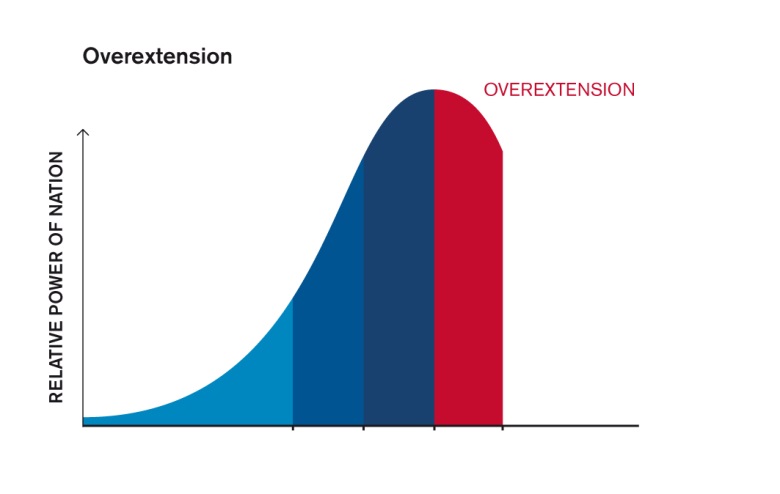
One way in which an empire can attempt to reduce defence costs is by building new alliances to spread the load - although doing so only delays the inevitable at best. However, it is worth noting that, when an empire overextends and then goes into decline, it is forced to scale back its influence in terms of both military presence and financial holdings. This spells the beginning of its end. (The rally of the US dollar in Autumn 2008 is a perfect example of this process; the fact that the US was forced to repatriate its wealth in order to support its collapsing core signified that its empire is now firmly in decline. The next stage will be the substitution of the dollar as the global currency by a challenger, which is likely to be the yuan - probably in as little as a decade.)
The social integration that began during the (preceding) maturity stage with the demand for full rights by disenfranchised citizens now progresses rapidly during the overextension stage. The composition of society by the end of this penultimate phase of the empire cycle will have dramatically altered. Formerly low-status classes can now gain entry to the empire’s power core. The barbarian auxiliaries drafted into the Roman legions, for example, gained leverage and ultimately control over Rome. The British Empire’s reliance on its colonies in both world wars helped to accelerate its break-up after World War Two as they demanded independence.
In the US, black Americans experienced a transition from slavery in the regionalisation stage to underclass in maturity. Black soldiers have served in US wars since the American Revolution, but, following the Vietnam War - in which they fought in greater numbers and in greater capacity than ever before - they pressed for validation as the civil rights movement intensified, and entered the middle and power classes. This increasing degree of social integration is perhaps most effectively symbolised by the 2008 election of the first black US president. (Figure 8 summarises these and other social changes within the Five Stage Empire Model.)
As the former underclass rises, a new wave of people from poorer nations fills the roles they have left behind. This process began in the last decade-plus in the US, with hundreds of thousands of mainly Mexican immigrants seeking new lives in the apparently (and certainly relatively) prosperous US, prepared to work on any terms.
The problem of manning the armed forces continues, and the social makeup of the military continues to evolve as a result. The core of the problem lies in the fact that society now has a greater proportion of older citizens than younger ones. As a result, its decision-makers become more conservative and less adaptive in solving the growing challenges of the empire’s decline.
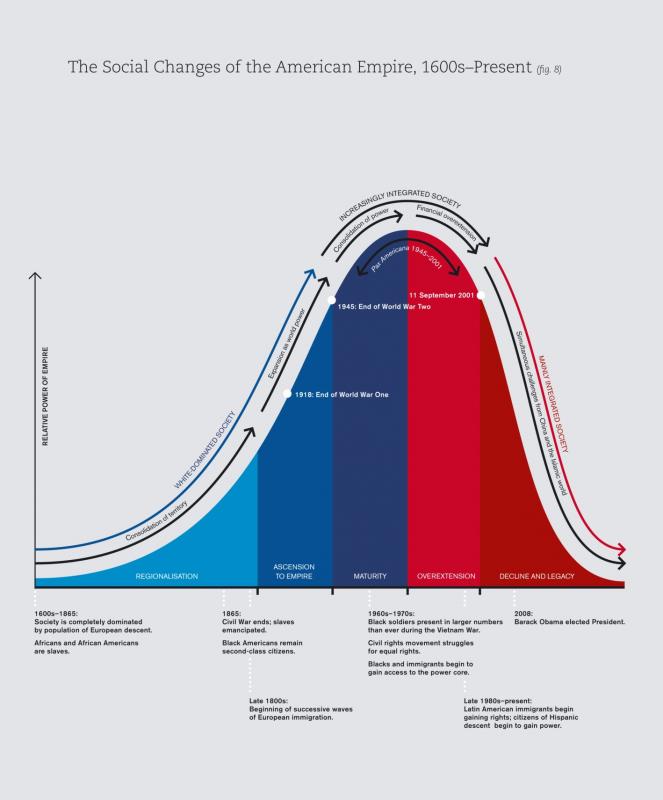
Decline and Legacy: The Fifth Stage of Empire
For an empire in the final throes of overextension, the cost of power vastly outweighs its economic benefit. Imperial sustainability becomes increasingly unfeasible, and the system rapidly begins to disintegrate. Although the signs would have been present during the overextension stage, other great powers would, for the most part, not have begun to recognise the waning empire’s vulnerability until the final stage of decline and legacy, when external and internal dynamics deteriorate at an alarming rate. Enemies on the periphery then awaken to the progressive ebbing of vitality, and become emboldened by incremental successes that can soon escalate. The old empire is now prey for other regional powers in the ascendant. The rate of decline surprises the world as a formerly iconic empire collapses.
The stage of decline and legacy can be described as the evolution of multi¬-polarity. The uni-polar world dilutes as the hegemon grows feebler, and challenging nations grow stronger and begin to exert a newfound influence. Characteristic of this stage is the empire’s collective denial that it is declining, expressed by the body politic and by the people themselves, who ask, ‘How can that which we have built up to be so splendid, so powerful, and which appeared so invincible, simply be erased?’
The illusion of the status quo, clung to during the overextension stage, now shatters. Often the catalyst is a key event, like the attacks on the US of 11 September 2001. The response by the leadership is to attempt to more deeply embody the perceived ‘original’ values of the empire. When their actions fail, a path is opened to new leadership, reflecting the new social order - and often the descendants of the former underclass, now risen, come to power. This process can appear as though hope has been renewed; yet it is, in effect, the beginning of the end of the empire. Near the end of the Western Roman Empire’s decline, the Germanic chieftain Odoacer (believed to be a Goth) became emperor - although he acknowledged allegiance to the deposed and permanently exiled emperor Julius Nepos. (The Visigoths and Vandals had sacked Rome long before, however, and many historians consider Odoacer’s reign as marking the Western Empire’s end.)
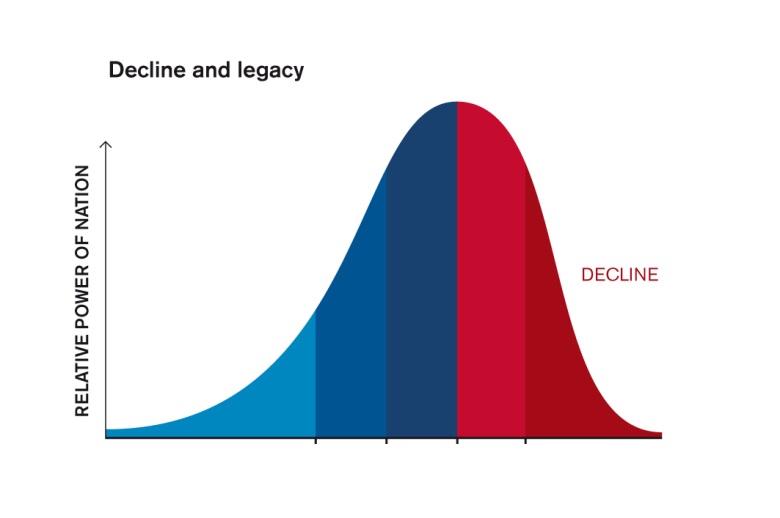
The final phase of this fifth and ultimate stage of empire is legacy. This endures to some degree after all empires have declined, but is best observed in the case of an empire that has had a rapid military ascension, driven by a strong leader who dies without a clear line of succession or sustainable administrative system (a recurring theme throughout history - the Macedonian and Mongol Empires have it in common, as does the first Islamic caliphate). Fragmentation usually precedes the decline of an empire of this sort, but very often a collective value system - its legacy - persists in the region in which it was formerly active, suffusing its smaller units and remaining until they are, in turn, subsumed by the next invading empire.
The advent of nuclear weapons and the accompanying threat of Mutual Assured Destruction (MAD) may well have altered the dynamics of decline, as borne out by the Cold War. Whereas in the past, empires in decline and legacy were often swallowed up, those wielding the nuclear advantage have the privilege of being protected by it as they re-form into their next incarnations. Europe has certainly benefited from this new model, as the US will, particularly as its missile shield defence system is developed further.
Europe is an example of a region in legacy. Following the collapse of its empires post-World War Two, it has gradually been attempting to rebuild itself into the European Union (EU) which seeks to subsume nations into a greater collective. However the reality is that the EU is a forced agglomeration of nations around a once powerful modern Germany. Today the demographics of the EUs core nations have all turned negative. The clear implication being that the EU will be unable to survive in its current form for much longer. As such Brexit represent a power shift from Germany to Britain and in time we once the EU has fallen apart we would expect the northern states to align themselves around Britain.
Today the best example of a nation in decline is America
https://www.davidmurrin.co.uk/blog-entry/the-deadly-dance-of-the-eagle-and-the-dragon-part-2-america-and-its-three-false-dawns
The Cost Of Empires
Empires cost enormous amounts of money to build and maintain. As such, their success is highly correlated to prosperity. History has seen evolution in the complexity not only of empires but also of the financial systems supporting them. With the Renaissance came the concept of government debt, which could finance a nation’s expansion. Britain was but one empire that benefited from this novel fiscal principle. Its empire’s debt-to gross domestic product (GDP) ratio clearly follows the Five Stages of Empire model (as shown in Figure 13):
1 Stages 1 and 2 (regionalisation and ascension to empire): the cost of the empire’s expansion is clearly shown by a dramatic increase in the ratio.
2 Stage 3 (maturity): the benefits of peace and profitable trade produce a massive empire dividend that returns the ratio to a low point.
3 Stage 4 (overextension): the cost of the empire’s social structures and the defence burden required to fend off challengers increase, and so does the ratio – to levels slightly higher than the peak at the end of stage 2.
4 Stage 5 (decline and legacy): at a critical point, the empire breaks up and the spending required to maintain it decreases dramatically, ultimately returning the ratio to a low point.
As we have seen, Britain’s investment in its navy over the course of the pre-1914 arms race proved financially daunting, and, once the war began, soaring costs forced the empire to the brink (and, fatefully, to seek US aid). It is worth recalling that, in addition to funding its war machine and then its World War One Allies, the regular cost of maintaining the British Empire was already enormous. Its size and complexity required the Royal Navy to defend trade routes that crisscrossed all regions of the globe, along with overseas naval bases and coaling stations. Never in history had a single empire controlled not only a great landmass but also the world’s oceans. Its overextension thus also occurred on an unprecedented scale.
While government debt during the early stages of empire was owned by British citizens, in the last two stages it was owned predominantly by the US, which then used this hold over Britain to force it to withdraw during the Suez Crisis, effectively ending Britain’s imperial age.
America shows a very similar debt pattern to that of The British Empire. With one important difference, America has no cousin to pass its power baton too that will maintain similar core values. As a consequence its debt will expand to the point where finally when its hegemonic status is lost it will suffer a debt blow up and crisis.
Super Empires
I have discussed the concept of empires and their five-stage cycle of rise and decline, defining ‘empire’ as the highest level of social organisation in terms of the allegiance of a population. Considering the next step in the expansion of human societies as they grow more complex and as their populations multiply, we come to an even larger organised social system: the super-empire. Super-empires result from an advanced level of social development that transcends the limitations of empire. The fractals of a super empire consist of empires themselves.
The Super Roman Empire
The Roman Empire furnishes us with the original example of the super-empire phenomenon (see Figure 14). What would become the Western Empire after the fifth century ad began, as we have seen, in the eighth century bc, with the rise of Rome to soaring heights and then its gradual decline over 1,000 years
The Western Christian Super Empire (WCSE)
The next stage in the evolution of the super-empire phenomenon has its origins in Europe at a time when the Byzantine Empire was still a major force. The structure of the entity I call the WCSE was far more complex than the Roman Super-Empire, and it endures to the present day – albeit much changed. As the second of the world’s super empires, it is a forerunner of the ASE, which will be discussed in PRESENT. Applying the Five Stages of Empire model to the WCSE provides a new view of the last millennium of European history. (See Figure 15 for a graphical representation of the Five Stages of Empire model applied to the WCSE.)
The Asian Super Empire
For the first time since the early thirteenth century, when the Mongol Empire began a campaign of conquest extending from the Sea of Japan to the Danube, the world is feeling the burgeoning power and influence of Asia. The region is in the process of becoming the next global super-empire (see Figure 21). At present, it is comparable to the WCSE between 1500 and 1870, with China in the lead, ascending to empire with the same expansive force as sixteenth-century Britain. India, a regional power, trails behind and is in many ways analogous to France during the WCSE’s ascendancy.
Comparing the nascent Asian Super-Empire (ASE) to the ascension of the WCSE makes further sense when considering the parallels of the ASE’s rapid population expansion. From Kazakhstan to Japan and from Mongolia to New Zealand, Asia contains well over 60 percent of the world’s population. It is, therefore, the repository of unparalleled human resources. Some of the most groundbreaking infrastructure in the world is being developed in the East, on an unprecedented scale, all of it powered by what I have called the Second Industrial Revolution.
The WCSE was a complex structure that was driven by competition between its constituent nations. Similar dynamics are in play between China, Japan and India, and their proxy allies. As in Europe, alliances might shift over time. I shall later posit that the likeliest scenario will see Japan and India forge closer ties in an attempt to limit Chinese power. For now, it is worth recalling the sobering fact that never in history has a rising economic power not chosen to grow its military infrastructure.
Wars and The Empire Cycle
Wars are the clocks of empires as shown by the diagram below for the WCSE. Once this simple truth is acknowledged, history can be unravelled, and lessons from the past placed into this context can directly inform both the present and the future.
The Five Stages of Empire is an instructive model for today’s multi-polar world, the wars of the WCSE are shown in Fig 42. More information is given in the Theory of War later in this theory section.
The driver behind the next major global conflicts will be caused by the rise of China as a revisionist military power. The dynamic of the new world order is shown in the below diagram of the great west to east power shift.
https://www.davidmurrin.co.uk/blog-entry/the-deadly-dance-of-the-eagle-and-the-dragon-part-6-conclusion
https://www.davidmurrin.co.uk/blog-entry/the-deadly-dance-of-the-eagle-and-the-dragon-part-5-the-chinese-strategy
https://www.davidmurrin.co.uk/blog-entry/china-now-the-most-powerful-economy-in-the-world
https://www.davidmurrin.co.uk/blog-entry/chinese-polarisation-part-iii-reducing-polarisation-and-remembering-a-time-when-china-and
The Great Power Shift from West To East.
The great West to East Power Shift is best exemplified by this diagram below that combines the path of the two Super Empires the WCSE and the ASE. It is ongoing and has reached a critical phase which will come to a head this decade in the 2025-27 period.
